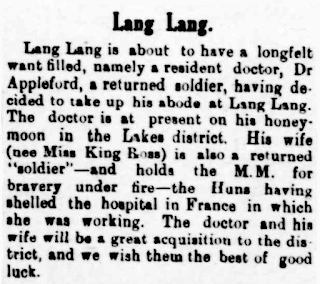The Bunyip and Garfield Express of October 4, 1918 had this following interesting account of a pub crawl by four lads - Frederick Sippo, Hugh Murdoch, Stephen McMillan (spelt as M'Millan in the article) and George Schmutter which saw the licensees of three hotels end up in the Bunyip Police Court on licensing charges.
Bunyip Police Court. Wednesday, Oct 2, 1918.
Before Messrs Tanner, P.M., and a’Beckett and Barker, J.’sP.
Licensing Prosecutions
Inspector M’Loughlin proceeded against Edward Augustus Dreier, licensee of the Iona Hotel, Garfield, for serving 3 persons, apparently under the age of 18 years, with liquour, on 3rd August last.
Mr Davine, for Mr Dunn who was ill and unable to be present, appeared for the defendant, who pleaded not guilty.
Permission was given to the inspector to amend the summons, as it was since found that one of the persons supplied was over 18 years.
Frederick Sippo, said on the day in question he went to the hotel at Garfield, where he had a few shandies; the drinks were supplied by Mrs Dreier, who never asked anything about his age; he was born on 10th Nov, 1901, and knew the difference between a soft drink and beer, as he had drank beer before.
In reply to Mr Davine witness said he told defendant prior to that date he was over 18.
Hugh Murdoch, aged 16, said a lady whom he did not know served them, and he had never previously told Drier he was over 18.
Stephen M’Millan, aged 18, also gave evidence as to being served, and that Dreier made a practice of keeping boys out of his hotel.
The defendant, who was away in the city on this day, said he always made it a practice of inquiring about young fellows ages, and had asked them to leave the billiard room if not 18. Mrs Dreier was in charge while he was away but he could not say if he asked their ages in the presence of his wife, but the three youths had previously told him they were over 18.
The Bench said the information would be dismissed, as defendant had evidently put his foot down on this matter by taking every precaution.
A similar charge was preferred against Henry Wilson, licensee of the Gippsland Hotel, Bunyip, for serving a person under 18 years of age on the same date.
The youth Sippo said he went into the hotel in company with G. Schmutter, who called for two drinks; he had a shandy, but had never had drink there before.
To Mr Davine (for Mr Dunn) – he was standing near the window in the bar parlor, so that the licensee did not have a full view of him; he knew now that Mr Wilson would not supply anyone under 18, and heard him refuse to serve Murdoch and M’Millan.
George Schmutter said he called for 2 drinks and Sippo had a shandy; Sippo would not be visible to the licensee when he served the drinks.
Without calling any evidence for the defense, the case was dismissed.
Inspector M’Loughlin v Thos. Stacey a similar charge to the previous one.
Mr Backhouse for the defendant.
Sippo again said he went into the bar with Schmutter and had a shandy, but he wouldn’t contradict Tom Stacy if he swore he refused to serve them.
G. Schmutter said he did not suppose Tom knew who he was getting the drinks for as there were several about; he remembered going to the side window for a bottle of wine.
Mr Backhouse said the licensee, who had never had a charge brought against him for over 20 years, had no knowledge that the lad Sippo had been served with liquour.
Thos Stacey, jun. said he refused drinks to a crowd and never at any time did he serve Sippo with drink; he only supplied Schmutter with a bottle of wine.
The licensee and R. M’Namara gave evidence that they were playing cards in the room behind the bar, and heard the previous witness refuse to serve them.
The Bench said they were satisfied that the youth had not been served, and dismissed the information.
In a Koo Wee Rup Sun article of this case it concluded with a pun. They reported that as Frederick Sippo was involved in all cases he was the youth who should not be allowed to sip drinks in a hotel (1).
I have written about the Iona Hotel at Garfield
here and the Gippsland and Railway Hotels at Bunyip,
here.
.................................................................................
Who were these boys?
Frederick Sippo. Frederick, born November 10, 1901 at Bunyip South, as Iona was then called, and was the son of Simon and Olive (nee Warren) Sippo. Listed in the Electoral roll at Iona, Simon was a contractor and bridge builder.
Simon Sippo bridge building in a flood
Olive died April 11, 1929, at the age of 65, and her death notice lists their children as Winifred, John (Jack), Ollie, Annie, Leslie, Charlie, Joe, Fred, Alfred and Ernie. The family were then living in Seddon, and she is buried at the Footscray Cemetery along with Simon, who died a few weeks later at the age of 68. Also in the grave is Frederick, who died at the Melbourne Hospital at only 32 years of age on September 3, 1934. (2).
Death notice of Frederick Sippo
Hugh Murdoch. Hugh James Murdoch was
born in 1902 in Balranald, NSW to George Petrie Murdoch and Emma Rose Parker, who had married in Balranald in 1897. Hugh was the brother to Arthur, Mary, Allan, Lily, Stanley, Archibald and Alice. George opened the Cora Lynn General Store in 1907 and operated it until 1922, and had also opened the Bayles General Store in 1921. You can read about the Cora Lynn store,
here and the Bayles store,
here. Hugh followed in the family trade as he is listed in the Electoral rolls as a shop assistant at Narre Warren, and later as a farmer, also at Narre Warren. Hugh married Elizabeth McMillan in 1924 and died August 16, 1994, aged 92. Elizabeth died in 1985 aged 82 and they are buried at the Bunyip Cemetery.
(3)
The death notice of Hugh's wife, Elizabeth.
The Age June 19, 1985, p. 31 newspapers.com
Stephen McMillan. Stephen was the brother of Elizabeth, Hugh Murdoch's wife. They were the children of Robert James and Bridget (nee Guthrie) McMillan. The births of Stephen and Elizabeth were registered in Dean in 1900 and 1903 and the Electoral rolls list them at Bullarook, near Ballarat. They later moved to a farm at Garfield. Bridget died in 1935 aged 70 and Robert in 1932, aged 68 and they are buried at the Bunyip Cemetery. Stephen married Sophia Joyce Baxter in 1922 and are listed in the Electoral Roll on farms at Cora Lynn and then Koo Wee Rup Road, Pakenham.
On June 4, 1941 Stephen enlisted in the Australian Army (SN VX57181). He said his birthday was December 26, 1902, so it seems he took three years off his age, and given that most men who lied about their age kept the actual day and month, he was most likely born December 26, 1899. He served in the Middle East, but was discharged January 4, 1943 on medical grounds. Stephen died in Frankston in 1960, aged 60 and he is buried at Frankston Cemetery. Sophia died in 1987 in Mount Martha aged 87. (4)
Death notice of Stephen McMillan
The Age, July 26, 1960, p 16. newspapers.com
George Schmutter. George was born at Bunyip South (Iona) in 1895, the son of William and Mary Ann (nee Hannington) Schmutter. This makes him about 23 when the pub crawl took place. However, the 1919 death notice of Mary Ann and the 1932 death notice of William both list their children as Henry, William, Agnes, Florence and Jack, with no mention of a George. There is a George Schmutter listed in the Electoral Rolls from 1916, the year George would have turned 21, with the occupation of labourer and address Iona, so that is likely to be him. George Schmutter married Ella May Chadwick in 1925 and they are in the Electoral Roll at Iona or Vervale up to at least 1949 and from the 1954 Roll they are living in Parramatta in New South Wales, where his occupation is a gardener. George died in South Melbourne in 1963, aged 68, and Ella died in Parramatta in 1977. I was unsure whether this fitted together, then I found Ella's death notice in the Sydney Morning Herald and George is called Jack, so that pulls all the pieces together, and confirms that George is the Jack listed in his parent's death notices. Then as double confirmation, Find a Grave has a photo of their memorials at the Rookwood General Cemetery in Sydney, and they have his name listed as George John Schmutter, hence the diminutive, Jack. (5).

Death notice of Ella Schmutter
Sydney Morning Herald, September 30, 1977 p.19. newspapers.com
George and Ella Schmutter's memorials at Rookwood Cemetery in Sydney
There is one remaining mystery with George/Jack. As you can see from his father's death notice, below, it states that he (Jack) was late A.I.F - a returned soldier. However, I cannot find any reference to him enlisting. To add to this mystery, the Iona Honour Board, lists a W. Schmutter, who I can't firmly identify, but I have written about this
here.
William Schmutter's death notice
Footnotes
(1)
The Koo Wee Rup Sun, October 9, 1918, see
here.
(2) Indexes to the Victorian Births, Deaths and Marriages; Electoral Rolls on Ancestry.com; Olive Sippo's death notice
The Age, April 13, 1929, see
here;
(3) Indexes to the Victorian and the New South Wales Births, Deaths and Marriages, Electoral Rolls on Ancestry.com;
(4) Indexes to the Victorian Births, Deaths and Marriages, Electoral Rolls on Ancestry.com;
(5) Indexes to the Victorian Births, Deaths and Marriages; Mary Schmutter's death notice
The Age March 15, 1919, see
here; William Schmutter's death notice
The Age, March 24, 1932, see
here; Electoral Rolls on Ancestry.com



















.jpg)
.jpg)

.jpg)
.jpg)
















